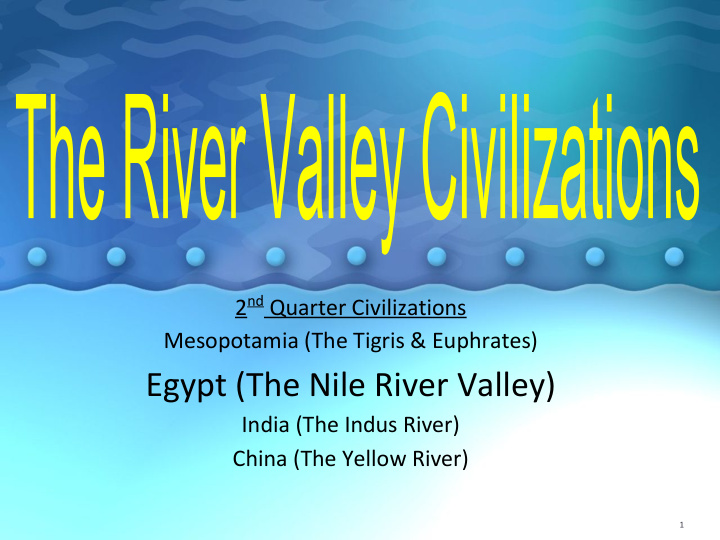



2 nd Quarter Civilizations Mesopotamia (The Tigris & Euphrates) Egypt (The Nile River Valley) India (The Indus River) China (The Yellow River) 1
2 nd Quarter 2017 ISN Table of Contents Even Odd Left Side Items Page # Right Side Items Page # BLANK ☺ New Table of Contents 0 1 BLANK ☺ Egypt L. Goal 2 3 Map of Egypt Geography & HEI 4 5 Social Class Pyramid Division of Labor 6 7 KING TUT/Game Pitch Religion in Culture & Gov’t 8 9 Mummification Process Cultural & Scientific 10 11 Khufu’s Pyramid Pharaoh Contributions 12 13 Egypt Study Guide Egypt CSA/Test 14 15 2
Learning Goal Students will be able to demonstrate understanding of Ancient Egypt’s government, geography, religion, cultural and scientific contributions as well as its influences on the development of later civilizations. Strand 2: Concept 2: PO 2, 3, 4, 5, 6, and 9 3
4
Ancient Egypt HEY! Where’s the RIVER? BRAINPOP Topic: Ancient Egypt- kyrenecentennial bpop 5
Ancient Egypt- Ch. 5 p.143 (ISN p.4) Label the following bodies of water & rivers, landforms, regions and cities. Bodies of Water & • Mediterranean Sea Rivers • Nile River • Red Sea • Gulf of Suez • Sinai Peninsula Landfor • Eastern Desert ms • Western Desert • Sahara Desert • Nile Delta Regions & Cities • Valley of the Kings • Valley of the Queens • Giza • Thebes • Abu Simbel 6
Why was the Nile River a gift for the Egyptians? Essential Question 7
Geography & HEI of Egypt ISN p.5 CUES NOTES • every year flooding provided fertile farmland in the desert and Using your Costa’s Levels of deposited silt Questioning- create • Ibis , white bird, would appear before the Nile would flood then a question(s) for the farmers could plant seeds these answers • Nile River: longest river in the world and flows south to north • Built irrigation canals & flood dams Using your Costa’s Levels of • To expand their farmland, created a tool called a shaduf , was Questioning- create used to spread water across the desert to increase farmland a question(s) for • Grew flax plants and wove its fibers into fabric called linen used these answers for clothing • Domesticated animals for food and service • Using your Costa’s Traded surplus goods along the Nile river Levels of • Fished and hunted wildlife Questioning- create • Mined copper and iron for tools/weapons a question(s) for • Used gold and gems for jewelry these answers 8
For centuries, THE NILE RIVER FLOODED THE VALLEY, enriching the land with a thick layer of sedimentary soil. Flooding occurred from July to September as the result of the tropical rains. The river attained its highest level in October, then began to recede to its lowest point sometime between April and June. 9
Domestication of Animals • LIVESTOCK was important to the Egyptian economy, supplying meat, milk, eggs, hides, and dung for cooking fuel. • Nothing was ever wasted. • A variety of DOMESTICATED ANIMALS were raised, including cattle, oxen, sheep, goats, pigs, ducks and geese. • They did not eat pork (pigs). • HERDSMEN and SHEPHERDS lived a semi-nomadic life, pasturing their animals in the marshes of the Nile. 10
TRANSPORTATION: The Nile River was the highway that joined the country together. Up until the nineteenth century, travel by land was virtually unknown. 11
How did work and social roles affect people in ancient Egypt? Essential Question 12
Division of Labor & Social Class Structure ISN p.7 CUES NOTES • People at the top ( government and royal family ) lived Using your Costa’s Levels of in palaces and ate fine food. Questioning- create a question(s) for these answers • People in the middle ( craft workers and scribes ) were Using your Costa’s Levels of well respected and often rich. Questioning- create a question(s) for these answers • The Egyptians at the bottom ( majority ) were poor Using your Costa’s Levels of and had to work very hard. Questioning- create a question(s) for these answers 13
Social Class Pyramid ISN p. 6 14
Recommend
More recommend